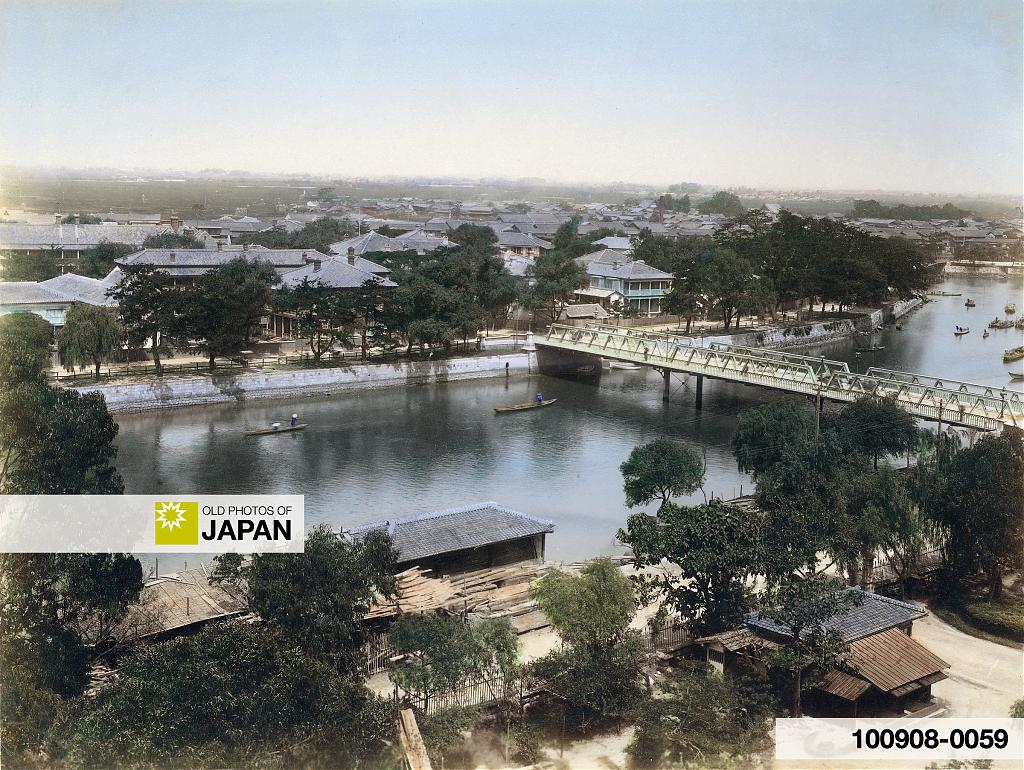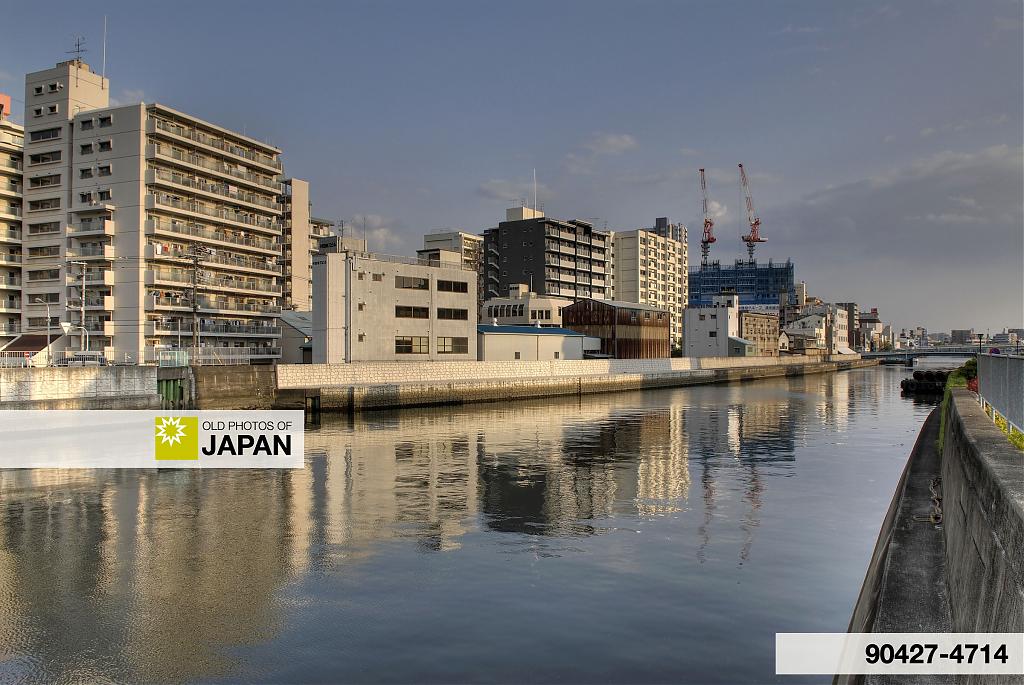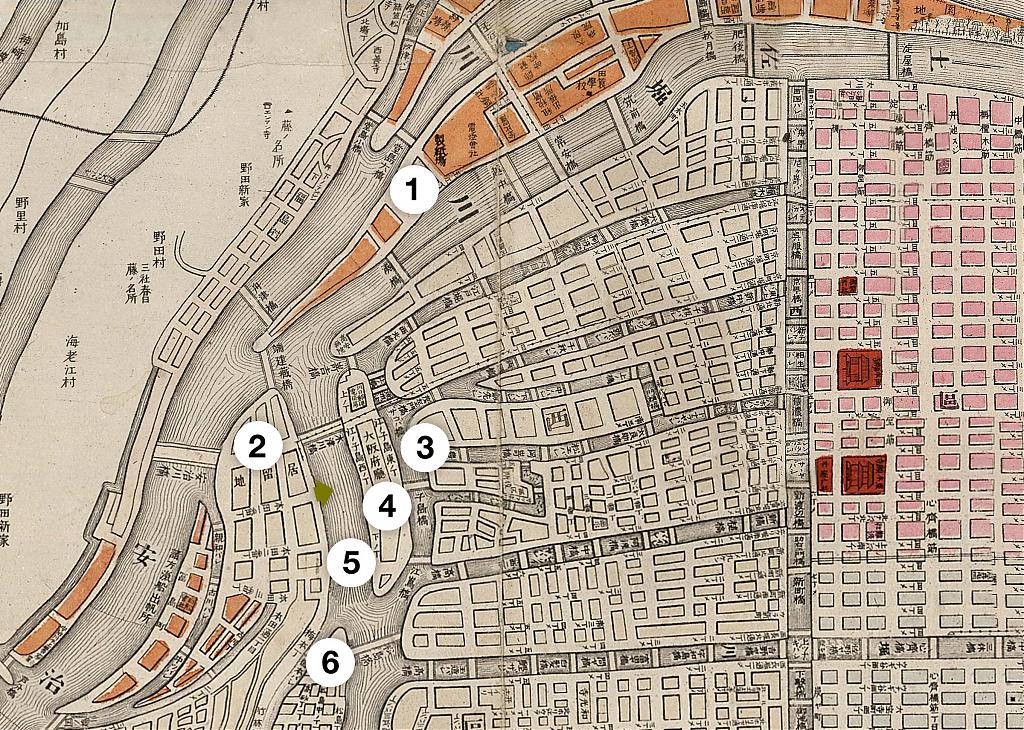Osaka Prefectural Office on Enokojima Island. From 1874 through 1926, the small island of Enokojima was the center of Osaka’s prefectural government.
A boat passes in front of the Osaka Prefectural Office on Enokojima Island (江之子島), between the Kizugawa River (木津川) and the Hyakkenbori Canal (百間堀).
Started in 1872 (Meiji 5) and completed in July 1874 (Meiji 7), the Neo-Renaissance style building featured an impressive dome on top. These days, Osaka’s prefectural government buildings are located in Otemae (大手前), facing Osaka Castle. But during the Meiji (1868-1912) and Taisho (1912-1926) periods, it was the small island of Enokojima which performed the role as Osaka’s governmental area.
Designed by Irish civil engineer and architect Thomas James Waters (トーマス・ジェームズ・ウォートルス, 1842–1898), the brick building in Neo-Renaissance style was Osaka’s first genuine Western-style building. It must have been extremely impressive to the eyes of the contemporary inhabitants of Osaka.
Stone steps lead to the entrance which bore four columns supporting a pediment with the Imperial chrysanthemum crest. On top of the building stood a monumental dome which offered a beautiful panorama of Osaka, which at the time still consisted mostly of low-rise wooden buildings.

A document of the time1 describes the building in admiring detail:
It follows the Western way of construction, and has stone foundations which are 2.7 meter deep; the walls, are of brick and 14.5 meter high; the tower with the dome is 30.3 meter. Every effort has been made to make the building beautiful. The four wooden columns at the entrance are, of the finest wood of zelkova trees, which stood in the compounds of temples or shrines in Kanda Village (Kita-ku). The logs were 14 meter long up to the thinnest part, the diameter at the thinnest part was 1.6 meter and at the butt it was 1.9 meter. Villagers considered the trees as sacred; nevertheless, they were cut down in April 1873 so as to promote the prestige of our government.
Chiyozo Akaho (赤保千代蔵) used to run a small restaurant opposite the Prefectural Office. In the early 1980s, when he was 86 years old, he recalled his memories of the building:2
Yes, it certainly was a fine building. It looked dignified and majestic. In those days, people did not go to the public office as freely or casually as they do now, and I was so glad when one day, a holiday, I was let in secretly by one of the, guards I had become acquainted with. I ran up the flight of stairs, all the way to the dome … It was as if we too, by the mere fact of living near the Government Office, had become more respectable.

Osaka’s government offices had been located in Uchi Hommachi in Higashi-ku. But with expansive plans for the development of Osaka’s harbor, the governor saw the future of Osaka in Enokojima, which was located near the harbor. The area was also right next to the Foreign Settlement in Kawaguchi and the red light district in Matsushima (松島). The rivers and canals were still full with boats transporting all the products that supplied the city. It was a lively and exciting place.
The river bank in front of the Prefectural Office had stone steps leading right to the water. It became an important landing place for the boats partlcipating in the river procession (funatogyo, 船渡御) of the Tenjin Matsuri (天神祭), one of Japan’s three most important annual festivals. Akaho remembered the event with fondness:3
All the people of the flotilla came ashore, one after another, the cows, the mikoshi… They all rested up in the front yard of the Prefectural Office and waited until everyone was there. Our place was a first-class location for viewing the procession.

The building was popularly called Nishi no Seifu (government of the west), which clearly suggests its importance. It would keep that importance until November 1926 (Taisho 15) when the prefectural government was moved to Otemae. The Enokojima building now became the Prefectural Industrial Promotion Office (大阪府工業奨励館), the current Prefectural Industrial Research Institute (大阪府立工業技術研究所), and kept this function until it was destroyed by bombs during the Second World War.
The Hyakkenbori Canal was filled in a long time ago, while the Kizugawa River’s beautiful stoned walls were replaced with ugly concrete banks. Tall apartment buildings now stand where once the Prefectural Office stood. The romance of the area has completely vanished.


Notes
1 Yomiuri Shimbun Shakaibu (1987). Scenes of Naniwa: Osaka Time Tunnel. Warajiya Publishing Co., Ltd, 129.
2 ibid.
3 ibid, 131.
Published
Updated
Reader Supported
Old Photos of Japan aims to be your personal museum for Japan's visual heritage and to bring the experiences of everyday life in old Japan to you.
To enhance our understanding of Japanese culture and society I track down, acquire, archive, and research images of everyday life, and give them context.
I share what I have found for free on this site, without ads or selling your data.
Your support helps me to continue doing so, and ensures that this exceptional visual heritage will not be lost and forgotten.
Thank you,
Kjeld Duits
Reference for Citations
Duits, Kjeld (). Osaka 1910s: Prefectural Office, OLD PHOTOS of JAPAN. Retrieved on December 12, 2025 (GMT) from https://www.oldphotosjapan.com/photos/692/osaka-prefectural-office-on-enokojima-island




There are currently no comments on this article.